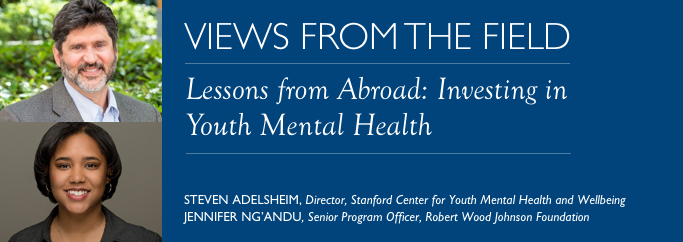
High school hit Jarrad hard. Outgoing and active as child, in his teens he became overwhelmed by crippling anxiety, to the point where he wandered back and forth between the bathrooms at opposite ends of the school just to avoid interacting with others. Although Jarrad tried to ignore what was going on, his mother finally convinced him to seek help. He got the support he needed from a youth-friendly community mental health program and learned how to manage his anxieties.
Jarrad’s story is similar to that of many young people in the United States, except for one thing: he actually got help. Nearly 80 percent of American youth with mental health problems do not. Jarrad is not American. He lives in Australia, which has a national program for supporting youth with early mental health needs.
Unfortunately, in the United States, we tend to view feelings like Jarrad’s as part of the normal ups and downs of adolescence, and assume that teens will grow out of them. The human brain is still developing very actively during these years, thus it is critical for young people to receive early support. But there aren’t enough options in the United States that promote mental health and well-being, or provide early intervention and treatment.
Now, more than ever, America stands to gain important insights from other countries that have developed comprehensive and effective approaches to youth mental health. Roughly half of all U.S. teens experience a mental health disorder at some point, and one in five suffers severe impairment. Mental health disorders are far more prevalent during adolescence; approximately 50 percent of disorders develop by age 14 and 75 percent by age 24.
While many adolescents may not experience the most serious mental illnesses, many have challenges that affect their ability to carry out daily functions. In a 2013 survey, teens reported higher stress levels than adults, and many said they felt overwhelmed or depressed because of stress. Additionally, an alarming number of U.S. youth have had traumatic experiences involving violence, abuse, neglect, or parents who have divorced or abused alcohol or drugs.
Left unaddressed, young people’s mental health problems affect their lives in other ways. Compared to youth in other industrialized countries, American youth are less likely to go to college and graduate. Our national youth suicide rate continues to increase, especially in early adolescence. Twenty percent regularly abuse alcohol, and rates of marijuana use by young people are at an all-time high. The United States has higher rates of teen pregnancy and sexually transmitted diseases than any other industrialized nation, and we continue to jail large numbers of young people for non-violent offenses.
Despite the extent of mental health challenges among teens and their potential effects, our country still has no comprehensive system for providing young people with early social-emotional support. When it comes to supporting youth mental health, other countries—including Australia, Ireland, Canada, Israel, and Denmark—are rejecting the norm that adolescents need to wade through these challenges on their own.
For example, headspace, the program that helped Jarrad, has become an important part of Australia’s mental health services landscape. headspace originated in response to calls from mental health experts concerned about the lack of services for Australian youth in the 12-to-25 age bracket. Australia was experiencing a youth mental health crisis, yet young people were not seeking help and they were not getting the care they needed. There are many reasons why young people don’t seek mental health services when they need them: not knowing where to go, fear of stigma, concerns about confidentiality, doubts about treatment effectiveness, lack of transportation, and cost. A youth-friendly mental health system must address these factors. headspace does.
headspace focuses on reaching young people with mild to moderate symptoms, many of whom present initially with depression or anxiety. Program workers provide young people access to early mental health services within an integrated care structure—in a setting that is youth-friendly, accessible, confidential, and free. The 100-plus headspace sites across Australia are one-stop, full-service shops designed specifically for young people with mental health issues, and include primary care, early addiction support, and help with education and employment.
headspace also operates an integrated, clinically-supervised, youth-friendly telephone and online therapeutic counseling and information service; a support service for secondary schools where students have been affected by suicide; and a service program for young people experiencing or at risk of developing early psychosis. Data show that headspace works, with improvements in 60 percent of clients. Most clients can get an appointment within two weeks of contacting headspace. This quick response is critical to young people who are averse to seeking care in the first place; it means fewer lost opportunities to provide support.
Australia and other countries recognized that their young people were in trouble and realized that most would benefit from early intervention mental health services. The United States can do the same. Physical health issues such as childhood obesity receive tremendous attention—and rightfully so. But youth mental health problems deserve the same level of attention.
Recently, several national media stories in this country have focused on the potentially negative impact of the Netflix series “13 Reasons Why,” which deals with the suicide of a high school student and how her friends’ behaviors contributed to her decision. The concern that teenagers watching this show might be at increased risk for self-harm or suicide contagion speaks to the emotional fragility of so many young people who are depressed, anxious, lonely, confused, and potentially resistant to getting help.
The good news is that we have a unique opportunity to build a robust mental health support system for young people in America. We have a strong body of research on which to draw, and we have successful programs from other countries for inspiration. With support from the Robert Wood Johnson Foundation, Stanford’s Center for Youth Mental Health and Well-Being is working to establish headspace-like programs in California. A new proposal being developed in partnership with Santa Clara County would open two such sites over the next 18 months, including one in San Jose and another near Palo Alto.
The turmoil that many adolescents experience is not just a phase. We have the opportunity to join the rest of the world in recognizing the unmet mental health needs of our young people. Let us invest in building a system that supports their healthy development into strong, resilient adults.

